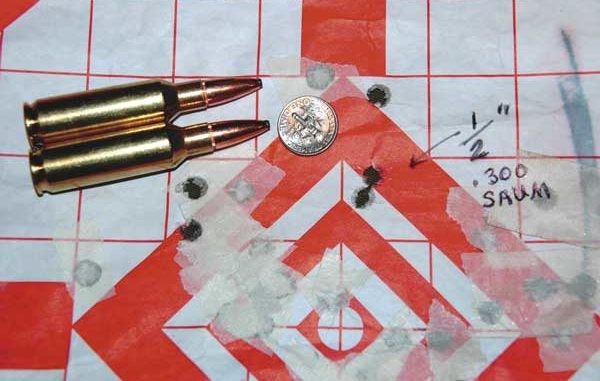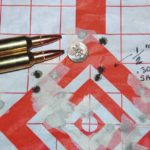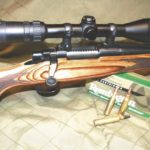
Beauty and versatility are in the eyes of the beholder, and most everyone I know in the shooting business is aware I have long been searching for the perfect hunting rifle. I wanted a rifle short enough to hunt from a tree platform, and not hang in the branches. But besides being shorter barreled, it had to have enough “cojones” to reach out and touch a deer at a distance like the magnum calibers I love to use.
Unfortunately, “magnum” velocities and their ballistic properties did not equate with the barrel lengths I was looking for. To get enough velocity to maintain a flat-shooting profile out to, say, 350 yards, it seemed you needed a 24-inch or longer barrel.
My beloved 7mm Magnum is a wood-stocked Parker-Hale with a Mauser-style claw extractor on the bolt, and a 26-inch barrel (I had it re-barreled after shooting the original sporter-weight barrel completely out). When we fitted the new medium-weight barrel, I worked up a load that would shoot three shots into one ragged hole at 100 yards. Needless to say, I was delighted.
But I was running into the same old frustrations of hunting pipelines one day out of box stands, and shooting from tree stands the next at ranges rarely reaching past 75 yards.
I thought I had found the perfect design several years ago in the Remington Model 7 bolt-action. Remington improved these fine little guns by lengthening the barrel to 20 inches (from an original, and too short, 18 inches), and giving them several more versatile cartridges, like the .260 Remington and the 7mm-08, both necked-down from .308 Winchester but with a heck of a lot more energy than the more-common .243 Winchester, another .308 derivative.
I bought a Model 7 for my daughter, and she took to it famously. She’s killed several deer with it, including a beautiful shot through a young buck at 180 yards — measured with a laser range finder. The 140-grain 7mm-08 was just the ticket out to 250 yards, after which it started dropping fast, shedding velocity and energy.
This year, Remington came out with new, improved versions of the Model 7, including 22-inch barrels on the Model 7 in their .300 SAUM, a shortened version of their Ultra Magnum cartridge. The 150-grain .300 SAUM develops 3,200 feet per second from a 24-inch barrel, according to Remington ballistic charts.
The factory ballistic tables compared the .300 Short Action Ultra Magnum to similar weighted bullets in the 7mm Remington Magnum and .300 Winchester Magnum, and the rate of drop at 200 and 300 yards was almost exactly the same.
Not a lot of writers discuss this cartridge, which is one of Remington’s forays into the marketing hurricane of the “short magnums” that have become all the rage in the last few years.
I have a great affinity for Remington rifles. There is a reason many of the fine custom riflemakers build their super-accurate and highly honed shooting instruments on the Remington Model 700 action. It is inherently one of the most accurate and dependable actions on the market today, and if you question that, run your own survey of top custom riflemakers, and see what type of bolt-action most of them offer. Remington rifles shoot good, frequently great, right out of the box.
Thus, I thought I might have found what I was looking for in the new Model 7 with the proprietary .300 SAUM. An article about Linda Powell, long-time press relations manager for Remington, stated she was a huge fan of the .300 SAUM, and had taken large game animals with it all over the continent. Powell is an accomplished shooter and huntress, and her affinity for the cartridge impressed me.
The problem was, I had a stainless rifle with a black, injection-molded stock in my daughter’s Model 7. I wanted something a little more traditional — and cosmetically more attractive.
Stainless and black polymer have their own utilitarian appeal, but nothing is more pleasing to the eye than a well-finished wood stock. And for all its attributes, stainless can never stand next to a deep polished “blue” on carbon steel, and still be considered handsome.
I knew what I wanted, and I agonized over it for several years.
As a younger man and fresh out of the Army, embarking on a professional career in North Carolina, I joined a small hunting club with a lease in the foothills of the Piedmont area about an hour out of Charlotte.
At a small country store down the road from the lease, I drove up one day to see two guys in a short-bedded 4×4 with a huge buck laying in the back. I don’t remember the number of points, or too much about the rack, other than it was one of the biggest sets of antlers I had seen at that early stage of my deer hunting career.
But what I did notice was the short-barreled bolt-action carbine the guys had stuck up on the antlers — the gun with which the lucky hunter had taken the buck.
It was a Model 600 Remington. It was the still-new .350 Remington Magnum cartridge. Much less popular was the other caliber offered in these guns — the 6.5 Remington Magnum, simply a necked-down version of the .350 Rem Mag.
The neat little rifle, introduced in 1964, carried an 18.5-inch barrel, a ventilated rib made from nylon, and an unusual “dogleg” bolt handle that put its tip in much closer proximity to the trigger, making for a quicker bolt throw in reloading. It also had a very unusual and (to my eye) attractive laminated stock of alternating beech and walnut layers — the differing colors of light and dark made for a handsome and hard wood, much less prone to warping in damp weather than standard wood stocks.
I never forgot that rifle, and over the years Remington toyed with the concept, dropping the design, then coming back with the Model 660, which lengthened the barrel to 20 inches, dropped the ventilated rib, and changed the radical bolt handle to a more mainstream design.
But there was still that question of cartridges. The .350 Rem. Mag. was lauded as effective for about anything on the North American continent, but it was a cartridge never able to reach its ballistic potential since the bullet had to be pressed so far into the case to fit in the short magazine box, the powder capacity was reduced. And I wanted further — not necessarily heavier.
The Model 660 never really caught on, and even though the range of cartridges was upped to include the .222 Remington, .223 Remington, .243 Remington, 6MM Remington, .308 Remington and .35 Remington, it was discontinued in 1971.
Of course, now these two rifles, in top condition, command premium prices in the used gun market because of their scarcity and unusual design.
Then in 2003, Remington introduced the descendent of these two neat little rifles, and to my hidebound, culturally retarded thought processes, came darn close to creating what I thought I wanted.
The 673 Guide Rifle was the newest version of their carbine-style bolt guns — and it improved the old guns while retaining the unusual features that had made them stand apart.
Designated with the “6” in recognition of its forbears, the 600 and 660, the “7” refers to the Model 7 action and platform on which it is built. The “3” refers to the year of its introduction, 2003.
Now with a 22-inch medium-taper barrel, the ventilated rib is back, but made from steel this time. The new version still retains the signature “shark’s fin” front sight that turned off a lot of gun writers, but one many others (including me) found added to its unusual look and attractiveness.
Some gun writers have noted the barrel does not seem to heat up as quickly in extended shooting sessions, and attribute that to the vented rib, which apparently acts as a heat sink. My experience proves this out — the barrel seems to stay cooler than my other guns.
And the gleaming, highly polished, laminated stock is back with distinctive, deeply cut checkering on the grip and an unobtrusive and well-formed Monte Carlo cheek piece. The metal finish is a deep, lustrous blue/black that contrasts beautifully with the unusual multicolored stock. This is not a rifle to disappear ignominiously into the dark anonymity of the gun rack. Set this one in the midst of a bunch of camp rifles, and you’d be able to pick it instantly in the dimmest of morning light.
The overall effect of this rifle is handsome, short and “stout” — able to handle all jobs and all demands — and I had to have one.
A lot of waffling and excuses caused me to wait, mainly because I kept hoping Remington would take pity and barrel this critter in a more mainstream caliber — the .300 SAUM just wasn’t melting the ammo sales counters with friction from being slid across glass tops.
Then, Remington did it to me again! They made my gun go extinct, dropping it from the line in 2005. After much agonizing, I finally realized it didn’t matter what caliber I bought — I would be reloading it anyway, and the .300 SAUM matched the .300 Win Mag and 7MM Rem Mag almost exactly in ballistic properties.
My worries over buying a discontinued model only to find it might not shoot well were groundless. Like every other Remington I have pulled from a box, it performed excellently — almost unbelievably so.
Using the new Remington Core-Lokt Ultra ammo with 150-grain bullets, I have now fired more than two boxes of shells through this new rifle. Mounting a Bushnell 3200 Elite 4-12×40 Rainguard scope on high Leupold mounts to raise it above the rib, I had exceptional clarity and did some final tuning on this rifle before putting it up for its summer rest.
Once I find a rifle reaches sub-minute-of-angle accuracy, and considering the cost of these short magnums, I start firing two-shot groups. Once I get dies, and work out a round, I won’t be so stingy with the groups, but my second group, the one I worked in exactly where I wanted it, was two shots practically touching — and this was only one of several like this I had fired on previous targets. The light recoil, due to the 7.5-pound weight of the rifle, made the short magnum a pleasure to shoot.
Needless to say, I am thrilled with my newest acquisition. The spartan, utilitarian handsomeness of the stainless and molded polymer stocks is not here — this one has flash and cockiness. It’s a bantam rooster with an assertiveness that comes from a long-line of can-do in the Remington lines.
But set aside your opinion on cosmetics pro or con, and look at those groups again — from factory ammunition! These are 150-grain bullets, ripping out at over 3,000 feet per second.
My ballistic charts tell me this one will shoot 1.3 inches high at 100 yards, dead point of aim at 200 yards and 6.4 inches low at 300 yards.
When you have a rifle/scope weighing in under 9 pounds, shooting that flat and tight, with a 150-grain wallop, and it’s coming from a 22-inch barrel that carries well wherever I take it, I can take a rest. I’ve found what I was looking for.
Gordon Hutchinson’s newest book, co-authored with Sportsman Editor Todd Masson, is The Great New Orleans Gun Grab, an expose’ of the gun confiscation scandal that occurred in New Orleans in the months following Hurricane Katrina. It can be found at www.neworleansgungrab.com.
Hutchinson’s first book, The Quest and the Quarry, is a generational tale that parallels the lives of a line of trophy bucks and the youth of a farming family that hunts them. It was chosen as a Book of the Year by the Southeastern Outdoor Press Association. It can be found at www.thequestandthequarry.com.
Both books can be ordered by calling 800-538-4355.




